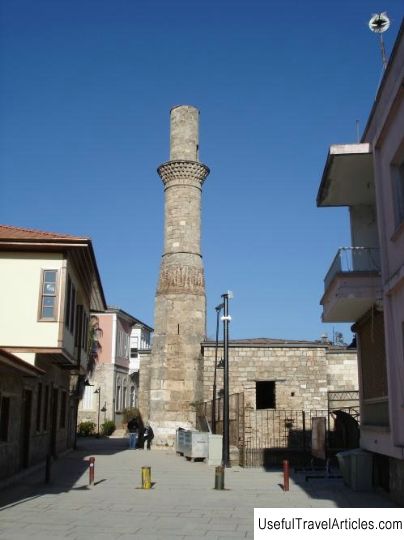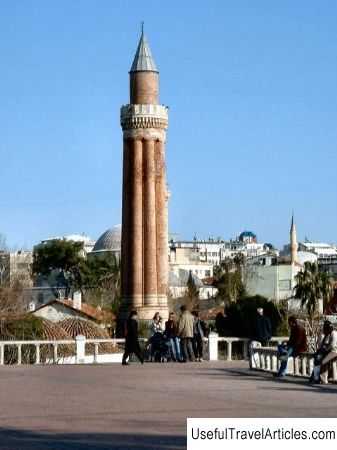Minaret Kesik (Kesik Minare) description and photos - Turkey: Antalya
Rating: 7,9/10 (646 votes) 
Kesik Minare description and photos - Turkey: Antalya. Detailed information about the attraction. Description, photographs and a map showing the nearest significant objects. The title in English is Kesik Minare. Photo and descriptionKesik Minare (Truncated minaret) is located near the ruins of the mosque and the Greek temple of St. Peter. Back in the nineteenth century, the tower was seriously damaged, but despite this, it deserves attention. The minaret is of architectural value and embodies a combination of different styles, which is especially noticeable thanks to the capitals. The building is decorated with reliefs along the edges of doors and windows and marble columns, and the vaulted gates lead into the minaret. The history of the minaret dates back to ancient times. As studies of the elements of the construction of the mosque have shown, its past stretched to the 2nd century AD. Then an ancient temple was located on this place. And in the 5th century, the Byzantines made it into the Church of the Virgin Mary. According to legend, a very valuable icon painted by Saint Luke was kept there. A patterned stone carving served as an icon frame. During the Arab invasions of the seventh century, the church received significant damage, but already in the tenth century it was restored and slightly expanded. In the XIII century, when Seljuk tribes began to dominate these lands, a minaret was attached to the church, the church turned into a mosque. In 1361, the Cypriot king Peter I conquered Antalya from the Seljuks, now the mosque is again becoming a Christian church. In 1361-1373, the city was occupied by the Cypriot Knights Hospitallers of the Order of St. John of Jerusalem and the church is used as a Christian Catholic church. Then it was again transformed into a church of Orthodox Byzantine Christians. In the fifteenth century, Shehzade Korkut, appointed by Sultan Bayazid II the ruler of Antalya, again turns the church into a mosque and calls it the Korkut Mosque (Korkut Jami). During the earthquake of 1480 described by Leonardo da Vinci, it was completely destroyed. In the nineteenth century, due to a lightning strike, the mosque is engulfed in fire. Only the minaret remains, which after the catastrophe has no top. There is no unequivocal answer to the question why the minaret became broken off. Some historians claim that these are the consequences of the fire, due to which the mosque itself collapsed, others say that the top of the structure was cut into the minaret by lightning. At present, the minaret still stands without a top, and the ancient building is in ruins. Therefore, the minaret is called the "Truncated minaret", or the Kesik minaret. Now the building with numerous damages is not used. However, it is shown to travelers as interesting ruins, where you can see a rare combination of building elements from ancient Byzantium and the Seljuk period. Whatever it was, but now Antalya has its "broken" attraction. The truncated minaret is regularly restored, but it is never completely repaired - the broken top of the minaret has already become a kind of symbol of Antalya.        Topic: Minaret Kesik (Kesik Minare) description and photos - Turkey: Antalya. |




